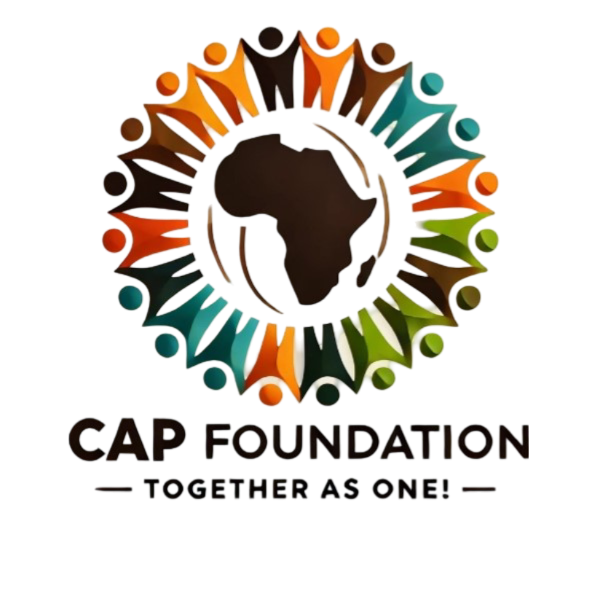OUR INITIATIVES
EDUCATION INITIATIVE
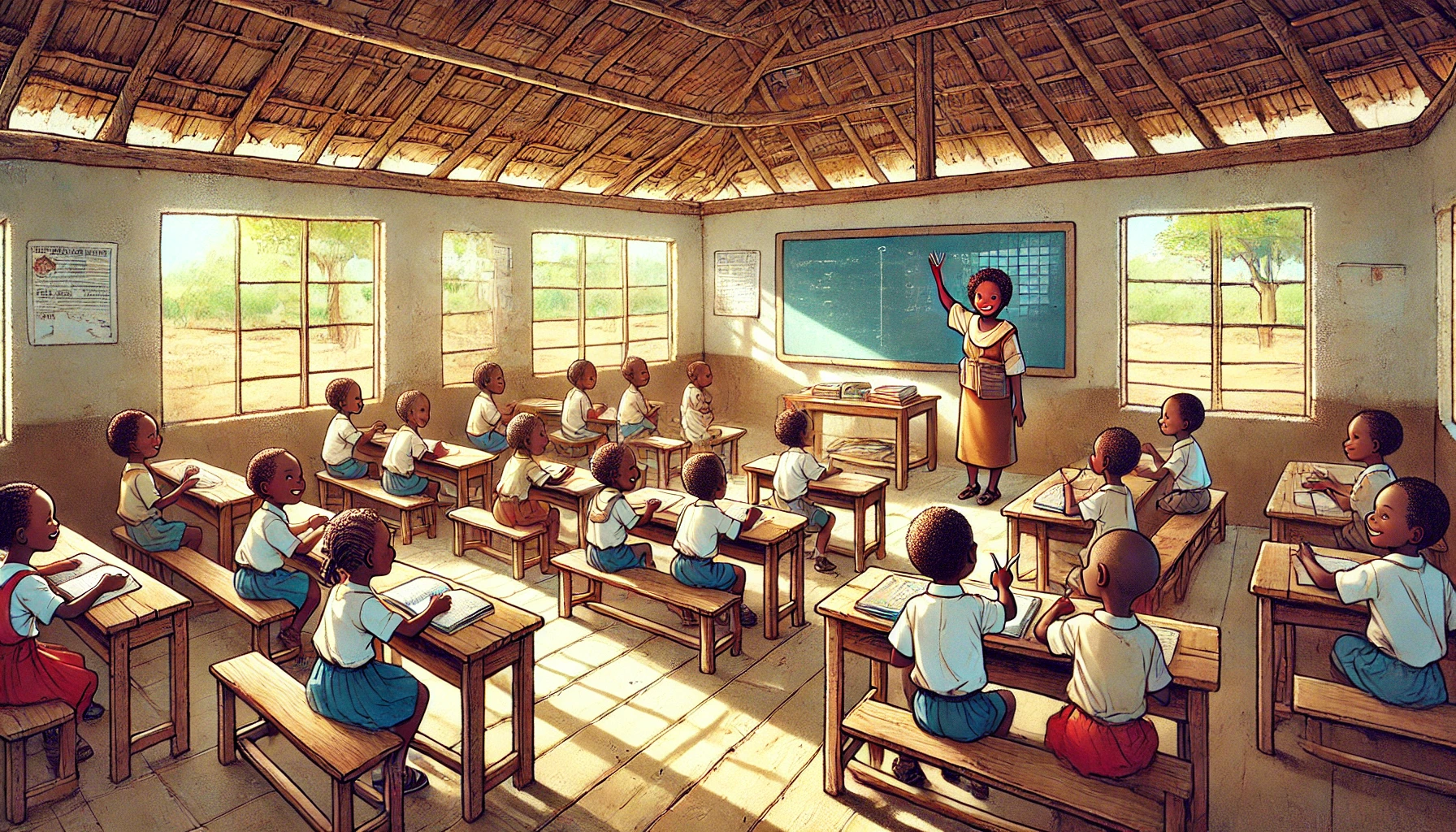
A heartwarming illustration of children in a simple school in a rural African setting. The classroom is made of basic materials such as wooden benches and a chalkboard. The children are happily engaging in learning activities, some holding books, others writing on small chalkboards. The environment reflects modest conditions, with sunlight streaming through windows made of wooden frames. The teacher, a caring adult, is standing by the chalkboard. The setting is surrounded by natural scenery, including trees visible through the windows.
Education plays a crucial role in fighting poverty in Africa by empowering individuals, improving economic opportunities, and promoting sustainable development. In many African countries, poverty is deeply entrenched, and access to education is limited, especially in rural areas. However, education can serve as the most effective tool to break this cycle of poverty.
First, education equips individuals with essential skills and knowledge, increasing their employability and earning potential. For example, children who receive a quality education are more likely to secure well-paying jobs, thus improving their standard of living and contributing to their community’s economic growth. Furthermore, educated individuals are more likely to start businesses, create jobs, and promote innovation, which fosters local economic development.
Moreover, education also has a significant impact on health outcomes, which is often linked to poverty. Educated individuals tend to make better decisions regarding nutrition, healthcare, and family planning, leading to improved health and well-being. This, in turn, reduces healthcare costs, increases productivity, and helps families escape poverty.
Additionally, when communities prioritize education, there is a generational shift. Educated parents are more likely to send their children to school, creating a cycle of knowledge and opportunity that continues for generations. This helps break the intergenerational transmission of poverty.
In conclusion, education is a powerful weapon in the fight against poverty in Africa. By providing access to quality education, individuals and communities can uplift themselves economically, improve their quality of life, and contribute to broader national development.
PROJECTS
The following projects address various educational barriers in Africa, including access, quality, and retention, while also ensuring that education becomes a powerful tool for economic and social transformation. By targeting underserved communities, providing skill development opportunities, and improving the quality of education, we’ll be able to play a pivotal role in breaking the cycle of poverty.
Click here to get in touch with us and/or contribute to any one or several of the projects listed below. You may also propose any other project that you feel impassioned to support...
Scholarship Programs for Vulnerable Children: Provide financial assistance for tuition fees, uniforms, and school supplies to ensure children from low-income families can attend school.
School Infrastructure Improvement: Build or renovate classrooms, libraries, sanitation facilities, and water supply systems in schools to create a better learning environment.
Mobile Schools and Learning Centers: Set up mobile schools or community-based learning centers in remote or nomadic communities to ensure access to education for children in underserved areas.
After-School Tutoring Programs: Provide after-school tutoring or remedial classes to help struggling students catch up and improve their academic performance.
Girl Education Advocacy: Run programs focused on promoting girls’ education by tackling barriers such as child marriage, early pregnancies, and gender-based violence, and offering scholarships or mentorship.
Adult Literacy Programs: Offer adult education and literacy classes to help illiterate adults gain basic reading and writing skills, improving their chances of employment and empowerment.
Vocational and Technical Training: Provide skills-based training programs in fields like agriculture, plumbing, carpentry, and technology, giving young people the tools they need to secure jobs or start businesses.
School Feeding and Nutrition Programs: Implement school feeding programs to provide nutritious meals to children, improving health and school attendance while increasing cognitive performance.
Teacher Training and Professional Development: Organize teacher training workshops to improve teaching quality, focusing on pedagogical skills, classroom management, and modern teaching methods.
Digital Learning Platforms: Develop online education resources, mobile apps, or e-learning platforms to provide remote access to quality educational content in underserved areas.
Early Childhood Education (ECE) Programs: Establish early childhood education centers to lay the foundation for lifelong learning, with a focus on language, social skills, and basic numeracy.
Peer Education Programs: Create peer mentoring or education programs where older students or trained peers help younger children with academic subjects, life skills, and emotional support.
Life Skills and Financial Literacy Training: Provide programs focused on essential life skills such as financial literacy, entrepreneurship, communication, and problem-solving, which are crucial for future self-sufficiency.
Community-Based Education and Training: Build community centers that offer continuous education and training in subjects like literacy, numeracy, agriculture, and small business management, reaching adults and youth in rural communities.
School Enrollment and Retention Campaigns: Conduct outreach campaigns to raise awareness about the importance of education and reduce dropout rates by offering support services such as counseling, tutoring, and financial assistance.
E-Book and Digital Resource Distribution: Distribute free or affordable e-books, digital textbooks, and learning materials to schools and students to provide affordable access to high-quality educational content.
Gender-Sensitive Education Programs: Develop gender-sensitive curricula and create programs that encourage both boys and girls to pursue education in traditionally gendered fields (e.g., girls in STEM and boys in teaching).
Water, Sanitation, and Hygiene (WASH) Programs in Schools: Implement WASH programs that provide clean water and proper sanitation facilities in schools to improve students’ health, attendance, and overall learning environment.
Community-Led Education Advocacy: Train and mobilize community leaders to advocate for better educational opportunities, policy changes, and increased investment in local schools, making education a community priority.
Public-Private Partnerships for Education: Forge partnerships with local businesses, governments, and international organizations to fund, resource, and support education initiatives that target poverty alleviation, such as school building projects, teacher training, or e-learning solutions.
AGRICULTURE INITIATIVE
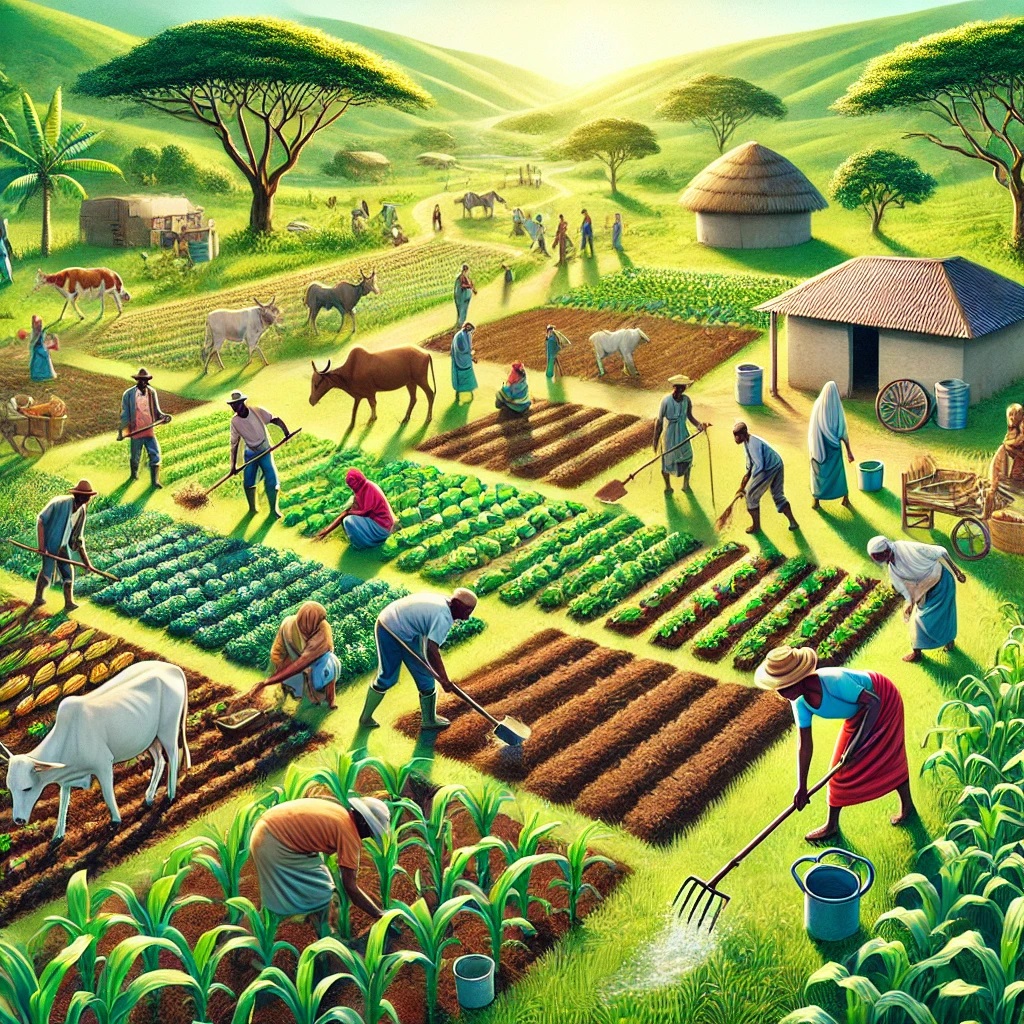
Agriculture holds immense potential to alleviate poverty in Africa, where a significant portion of the population relies on farming for their livelihoods. As the backbone of most African economies, the agricultural sector can drive economic growth, enhance food security, and create employment opportunities, contributing to poverty reduction.
One of the primary ways agriculture alleviates poverty is by providing a steady source of income. Smallholder farmers, who make up the majority of Africa’s agricultural workforce, can increase their earnings through improved farming practices, access to better seeds, and investment in irrigation. Enhancing productivity not only ensures food availability for households but also creates surpluses that can be sold in local and international markets.
Agriculture also promotes food security, a critical factor in reducing poverty. Malnutrition and hunger are prevalent issues in many parts of Africa, limiting people’s ability to work and learn effectively. A robust agricultural sector ensures an abundant supply of nutritious food, improving health outcomes and enabling communities to break free from poverty cycles.
Furthermore, agriculture stimulates economic activity in related industries, such as food processing, storage, and transportation. These activities create jobs along the value chain, particularly in rural areas, where employment opportunities are often limited.
By investing in agricultural innovation, infrastructure, and education, African nations can empower farmers to harness the full potential of the land. Modern techniques, sustainable farming practices, and market access can transform agriculture into a powerful tool for economic development, ultimately lifting millions out of poverty.
PROJECTS
These projects aim to address key challenges in agriculture, such as access to resources, training, market access, and sustainability, while helping smallholder farmers improve their productivity, income, and resilience. By empowering farmers with the knowledge, tools, and financial support they need. We aim to contribute to poverty reduction and long-term food security in Africa..
Click here to get in touch with us and/or contribute to any one or several of the projects listed below. You may also propose any other project that you feel impassioned to support...
Farmer Training and Capacity Building: Provide training programs to smallholder farmers on modern, sustainable farming techniques such as crop rotation, pest management, and organic farming to increase productivity and reduce costs.
Access to High-Yield and Climate-Resilient Seeds: Distribute high-quality, drought-resistant, and high-yield seeds to smallholder farmers to help them increase crop production and adapt to changing climatic conditions.
Microfinance and Agricultural Credit: Provide low-interest loans or microfinance services to farmers, enabling them to access seeds, fertilizers, equipment, and other essential inputs to enhance productivity.
Establishment of Agricultural Cooperatives: Create or support farmer cooperatives to allow small-scale farmers to share resources, access markets collectively, and negotiate better prices for inputs and outputs.
Market Linkages and Direct Marketing Platforms: Facilitate direct connections between farmers and buyers (such as local markets, wholesalers, and exporters) to eliminate middlemen and ensure better prices for farm produce.
Post-Harvest Loss Reduction: Train farmers in proper post-harvest handling, storage techniques, and preservation methods to reduce food waste and ensure more produce can be sold at a fair price.
Sustainable Irrigation Solutions: Implement small-scale irrigation systems like drip or sprinkler irrigation, enabling farmers to grow crops more consistently, even during dry seasons, and improve yields.
Climate-Smart Agriculture (CSA) Practices: Promote climate-resilient farming techniques such as water-efficient farming, agroforestry, and the use of drought-tolerant crop varieties to help farmers adapt to climate change.
Agroprocessing and Value Addition: Support the development of agroprocessing enterprises that can transform raw agricultural products (e.g., turning maize into flour or cassava into starch), creating jobs and increasing farmers’ income.
Sustainable Livestock Farming: Train farmers in improved livestock management techniques, including rotational grazing, disease control, and improving animal nutrition, to increase meat, milk, and egg production.
Soil Fertility Management: Educate farmers on soil health management techniques such as composting, mulching, and the use of organic fertilizers to improve soil fertility, increase crop yields, and reduce dependency on chemical fertilizers.
Community Seed Banks: Establish community-based seed banks where farmers can access high-quality, locally adapted seeds, improving food security and agricultural resilience in the long term.
Agri-Tech Solutions: Introduce farmers to digital tools and mobile apps that provide weather forecasts, market prices, pest alerts, and farming advice to improve decision-making and productivity.
Water Harvesting Techniques: Promote rainwater harvesting systems to ensure reliable water supplies for farming, reducing the dependence on erratic rainfall and improving crop yields in dry seasons.
Agroforestry and Carbon Farming: Implement agroforestry projects that integrate trees into farming systems to improve soil health, provide additional sources of income, and sequester carbon to combat climate change.
Youth in Agriculture Programs: Create programs that engage young people in agriculture through education, mentorship, and access to land, aiming to revitalize the agricultural sector and address the aging farmer population.
Gender-Sensitive Agricultural Programs: Design agricultural initiatives that specifically address the needs of women farmers, such as providing access to land, credit, training, and resources to ensure that women can fully participate in and benefit from agriculture.
Food Security and Nutrition Programs: Educate farmers about diverse and nutritious crops, such as biofortified crops or vegetables, to improve family nutrition and create food security at the household level.
Agri-Tourism Development: Support rural communities in developing agri-tourism ventures, where farmers can offer tours, farm stays, and direct sales to tourists, providing an additional source of income for farming communities.
Farmer Field Schools: Establish farmer field schools where farmers can learn from experts, exchange knowledge, and experiment with different agricultural techniques, helping them adopt more efficient and sustainable farming practices.
WATER & SANITATION INITIATIVE
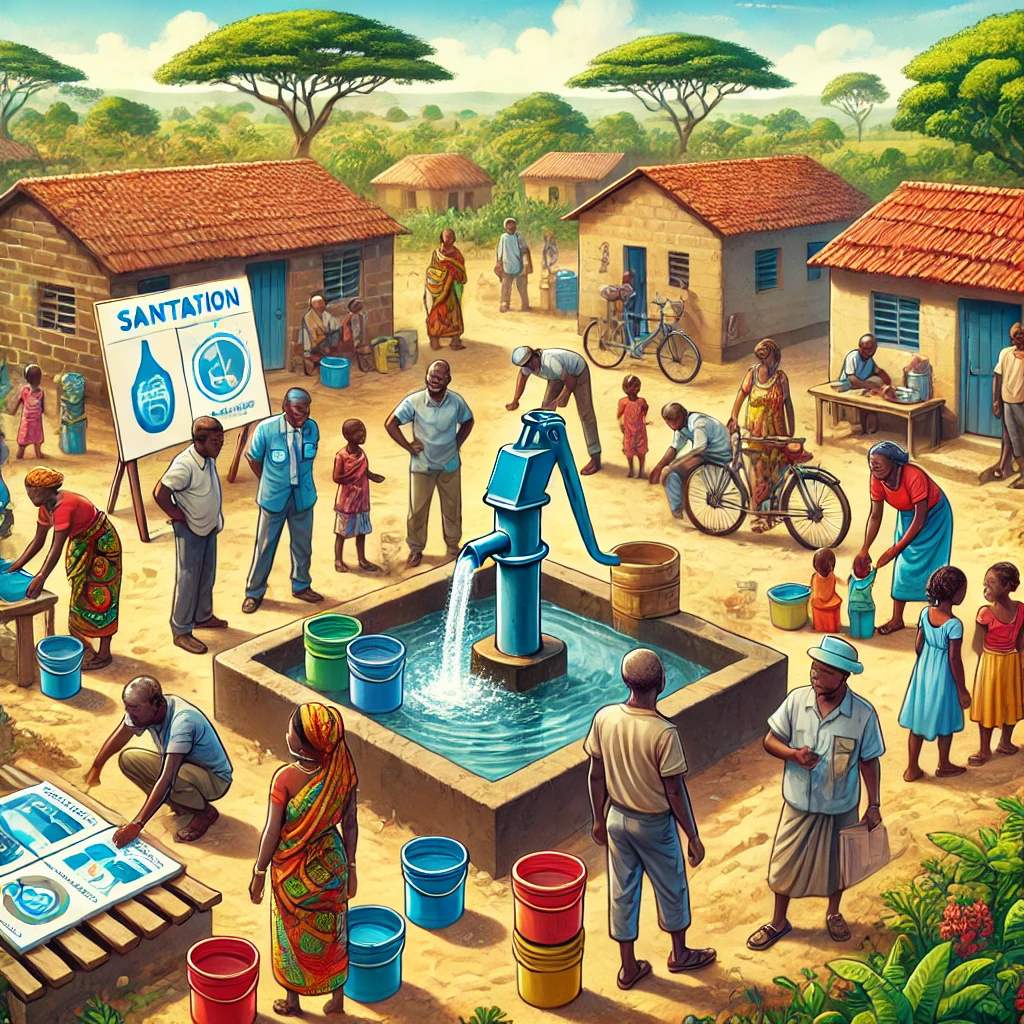
A water and sanitation activity in Africa, highlighting community efforts to alleviate poverty.
Access to clean water and proper sanitation is crucial for alleviating poverty in Africa. Millions of people on the continent still lack these basic necessities, which not only affects their health but also perpetuates poverty cycles. Improving water and sanitation infrastructure can significantly enhance quality of life, boost economic productivity, and reduce poverty.
Health is directly tied to water and sanitation. Contaminated water and poor sanitation are leading causes of diseases like cholera, diarrhea, and typhoid, which disproportionately affect children and vulnerable populations. These illnesses drain family resources through healthcare costs and lost income, keeping many in poverty. By ensuring access to clean water and safe sanitation, communities can prevent these diseases, allowing individuals to lead healthier, more productive lives.
In addition, access to water saves time, particularly for women and girls who often bear the burden of fetching water. In rural Africa, many spend hours daily walking long distances to collect water, time that could otherwise be used for education or income-generating activities. Providing accessible water sources can empower women and girls, leading to improved education outcomes and greater gender equality.
Water and sanitation also underpin economic development. Access to reliable water sources supports agriculture, the backbone of many African economies, while improved sanitation reduces environmental degradation, ensuring sustainable resource use.
In conclusion, investing in water and sanitation is a critical step in breaking poverty cycles in Africa. It promotes health, enhances productivity, and creates opportunities for education and economic growth, laying the foundation for a brighter, more equitable future.
PROJECTS
These projects and initiatives can significantly improve access to clean water, sanitation, and hygiene (WASH) services in communities across Africa, contributing to better health, education, and economic outcomes, while reducing poverty and promoting sustainable development.
Click here to get in touch with us and/or contribute to any one or several of the projects listed below. You may also propose any other project that you feel impassioned to support...
Clean Water Access Projects: Construct wells, boreholes, and water pumps in underserved communities to provide access to safe and clean drinking water, reducing waterborne diseases and improving health.
Rainwater Harvesting Systems: Install rainwater harvesting systems in schools, homes, and community centers to capture and store rainwater, ensuring a reliable water source during dry seasons.
Community-Based Water Supply Systems: Develop sustainable water supply systems, including gravity-fed systems and solar-powered pumps, that can be managed by local communities to ensure long-term water availability.
Water Purification and Filtration: Provide water filtration systems (such as bio-sand filters or solar distillers) to purify contaminated water and make it safe for drinking, reducing waterborne diseases.
Sanitation Infrastructure (Toilets and Latrines): Build and maintain hygienic toilets and latrines in schools, communities, and health centers, promoting good sanitation and reducing the spread of diseases.
Hygiene Education and Awareness Campaigns: Implement hygiene education programs that teach communities about the importance of handwashing, proper waste disposal, and safe water storage to reduce disease transmission.
Menstrual Hygiene Management Programs: Provide education, sanitary products, and safe disposal methods for menstrual hygiene to girls and women, ensuring that menstruation does not interfere with their education or health.
Community Water Management Committees: Establish community-based water management committees to ensure the sustainable operation, maintenance, and equitable distribution of water resources.
Water Supply for Schools: Build or rehabilitate water supply systems in schools to ensure that students have access to clean water, which improves their health, attendance, and academic performance.
Wastewater Treatment and Recycling: Set up low-cost wastewater treatment systems that recycle water for agricultural or non-potable uses, helping conserve water resources and improve sanitation in urban and rural areas.
Sanitation in Healthcare Facilities: Improve sanitation and waste disposal systems in health clinics and hospitals to prevent the spread of infections and provide better healthcare services to vulnerable populations.
Pumping Systems for Irrigation: Implement small-scale solar-powered irrigation systems that provide water for agriculture, boosting food security, and providing livelihoods for farmers in areas facing water scarcity.
Water Conservation and Management Training: Conduct training on water conservation techniques for households and farmers, promoting water-efficient practices like drip irrigation, mulching, and rainwater storage.
Water Quality Monitoring and Testing: Establish community-based water quality monitoring programs to regularly test and ensure the safety of local water sources, helping to prevent contamination and protect public health.
Ecological Sanitation Systems: Promote ecological sanitation (eco-san) systems that treat human waste and convert it into compost or biogas, reducing environmental pollution and providing a sustainable alternative to conventional sewage systems.
Access to Toilets for Rural Communities: Build and distribute low-cost, mobile, or easy-to-assemble toilets for rural and remote communities that lack basic sanitation facilities, improving health and dignity.
Water Wells and Clean Drinking Water for Remote Areas: Focus on reaching remote and isolated communities with water wells, ensuring that even the most vulnerable populations have access to clean drinking water.
Sanitation Marketing and Hygiene Products Distribution: Create sanitation markets by promoting the sale and distribution of low-cost, locally manufactured hygiene products such as sanitary pads, soap, and water purification tablets.
Community-Led Total Sanitation (CLTS) Campaigns: Implement CLTS programs that involve the community in building and maintaining sanitation facilities, while encouraging behavior change to end open defecation and improve sanitation practices.
Mobile Water Solutions for Emergency Relief: In areas affected by natural disasters or conflict, provide mobile water filtration systems or emergency water distribution systems to ensure that displaced populations have access to safe water.
ENVIRONMENTAL CONSERVATION INITIATIVE
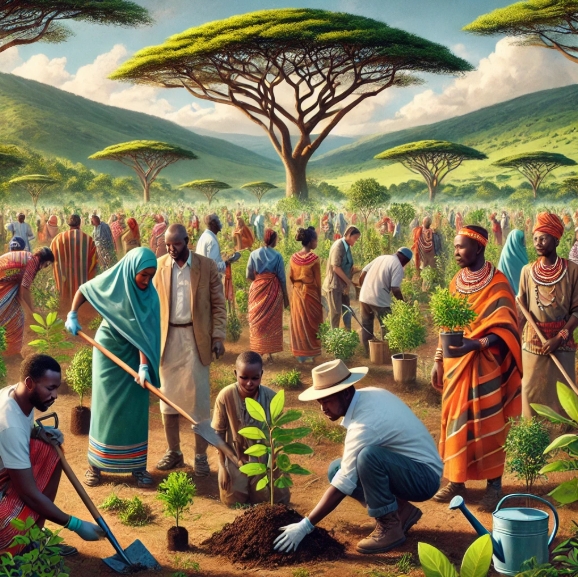
An illustration of an environmental conservation activity in Kenya, featuring tree planting in a community effort.
Environmental conservation plays a vital role in alleviating poverty in Africa by safeguarding the natural resources upon which millions depend for their livelihoods. The continent’s economy is largely reliant on agriculture, forestry, and fishing, all of which are directly affected by environmental degradation. When ecosystems are preserved, they provide essential services such as clean water, fertile soil, and biodiversity, which sustain livelihoods and promote food security.
Deforestation, soil erosion, and desertification are pressing challenges in Africa, often exacerbated by poverty-driven exploitation of resources. Conservation initiatives, such as reforestation programs and sustainable agricultural practices, help reverse these trends. By restoring degraded lands, communities can increase agricultural productivity and reduce the need to encroach on forests for farming, thus creating a cycle of sustainable development.
Additionally, conservation projects often introduce income-generating opportunities, such as ecotourism, which provides jobs while preserving wildlife and natural landscapes. Countries like Kenya and South Africa have successfully leveraged their rich biodiversity to attract tourists, generating revenue for local communities. Similarly, renewable energy projects, such as solar and wind farms, promote environmental sustainability while creating employment and reducing energy poverty.
Investing in environmental conservation also mitigates the impacts of climate change, which disproportionately affects the poor. By building climate resilience through sustainable practices, communities are better equipped to cope with extreme weather events, thus protecting their livelihoods and reducing vulnerability to poverty.
In conclusion, environmental conservation is not just an ecological necessity but a critical strategy for alleviating poverty in Africa. Sustainable management of natural resources ensures long-term economic growth and resilience, fostering a healthier and more prosperous future for all.
PROJECTS
These projects or initiatives address key environmental challenges while providing economic opportunities, improving livelihoods, and promoting sustainable development. By integrating environmental conservation with poverty alleviation, we intend to create long-lasting, positive changes that benefit both people and the planet in Africa.
Click here to get in touch with us and/or contribute to any one or several of the projects listed below. You may also propose any other project that you feel impassioned to support...
- Reforestation and Afforestation Programs: Plant trees in deforested or degraded areas to restore ecosystems, prevent soil erosion, and provide long-term resources such as timber, fruits, and firewood for local communities.
- Sustainable Agriculture Practices: Promote agroecology and sustainable farming techniques that preserve soil health, reduce water usage, and enhance biodiversity, helping farmers to increase yields and protect the environment.
- Community-based Wildlife Conservation: Establish programs that engage local communities in wildlife conservation efforts, including sustainable ecotourism initiatives and community-managed wildlife reserves that generate income and create jobs.
- Water Conservation and Management: Develop projects that promote the sustainable management of water resources, including rainwater harvesting systems, water storage tanks, and irrigation systems that increase access to clean water for farming and drinking.
- Alternative Energy Solutions: Provide access to renewable energy solutions such as solar cookers, solar lamps, and biogas, which reduce reliance on wood and charcoal, mitigate deforestation, and improve health by reducing indoor air pollution.
- Waste Management and Recycling Initiatives: Introduce waste management programs that promote recycling, composting, and proper disposal methods, helping communities reduce environmental pollution and creating jobs in waste management.
- Education and Awareness Campaigns on Environmental Issues: Conduct public education campaigns to raise awareness about environmental challenges like deforestation, pollution, and climate change, encouraging communities to adopt environmentally friendly practices.
- Sustainable Fisheries Management: Work with local fishing communities to implement sustainable fisheries practices, such as establishing marine protected areas, promoting responsible fishing, and preventing overfishing to ensure long-term livelihoods.
- Eco-friendly Infrastructure Development: Support the construction of sustainable housing, eco-friendly schools, and community buildings using locally sourced and renewable materials, reducing the environmental footprint while providing much-needed infrastructure.
- Soil Conservation and Erosion Control: Implement soil conservation techniques, such as terracing, agroforestry, and the use of cover crops, to prevent soil erosion and improve agricultural productivity, enhancing food security and livelihoods.
- Climate Change Mitigation and Adaptation Programs: Educate and support communities in adopting climate-resilient agricultural practices, disaster preparedness, and adaptive technologies that protect livelihoods from the adverse impacts of climate change.
- Community-based Forest Management: Empower local communities to manage and protect their forests through community-based forestry programs that provide sustainable livelihoods and resources, such as honey, timber, and non-timber forest products.
- Sustainable Livestock Management: Promote sustainable livestock management practices, such as rotational grazing, improved animal health care, and land regeneration, which help maintain healthy ecosystems while improving the income and food security of pastoral communities.
- Clean Cooking Solutions: Provide clean cooking stoves and alternative cooking technologies to reduce dependence on wood and charcoal, reducing deforestation and improving health outcomes for women and children who traditionally collect firewood.
- Wildlife and Forest Conservation for Ecotourism: Support the development of ecotourism initiatives that encourage the conservation of wildlife and forests, creating sustainable livelihoods for local communities through tourism-related jobs.
- Environmental Advocacy and Policy Lobbying: Advocate for strong environmental policies at local, regional, and national levels that protect natural resources, promote sustainable development, and address environmental justice issues affecting vulnerable communities.
- Biodiversity Protection and Restoration: Implement programs aimed at protecting and restoring endangered species and ecosystems, promoting biodiversity conservation through local engagement and community-driven initiatives.
- Agroforestry Projects: Support the integration of trees into agricultural systems (agroforestry), which can improve soil fertility, provide food and timber resources, increase farm income, and contribute to carbon sequestration.
- Sustainable Land Management: Educate and provide support for communities to adopt sustainable land management practices, such as crop rotation, agroforestry, and no-till farming, to improve land productivity and protect ecosystems.
- Promoting Green Enterprises: Encourage the development of green businesses, such as organic farming, eco-tourism, or solar energy enterprises, which provide environmentally sustainable job opportunities and help reduce the environmental impact of traditional industries.
HOUSING & SETTLEMENT INITIATIVE
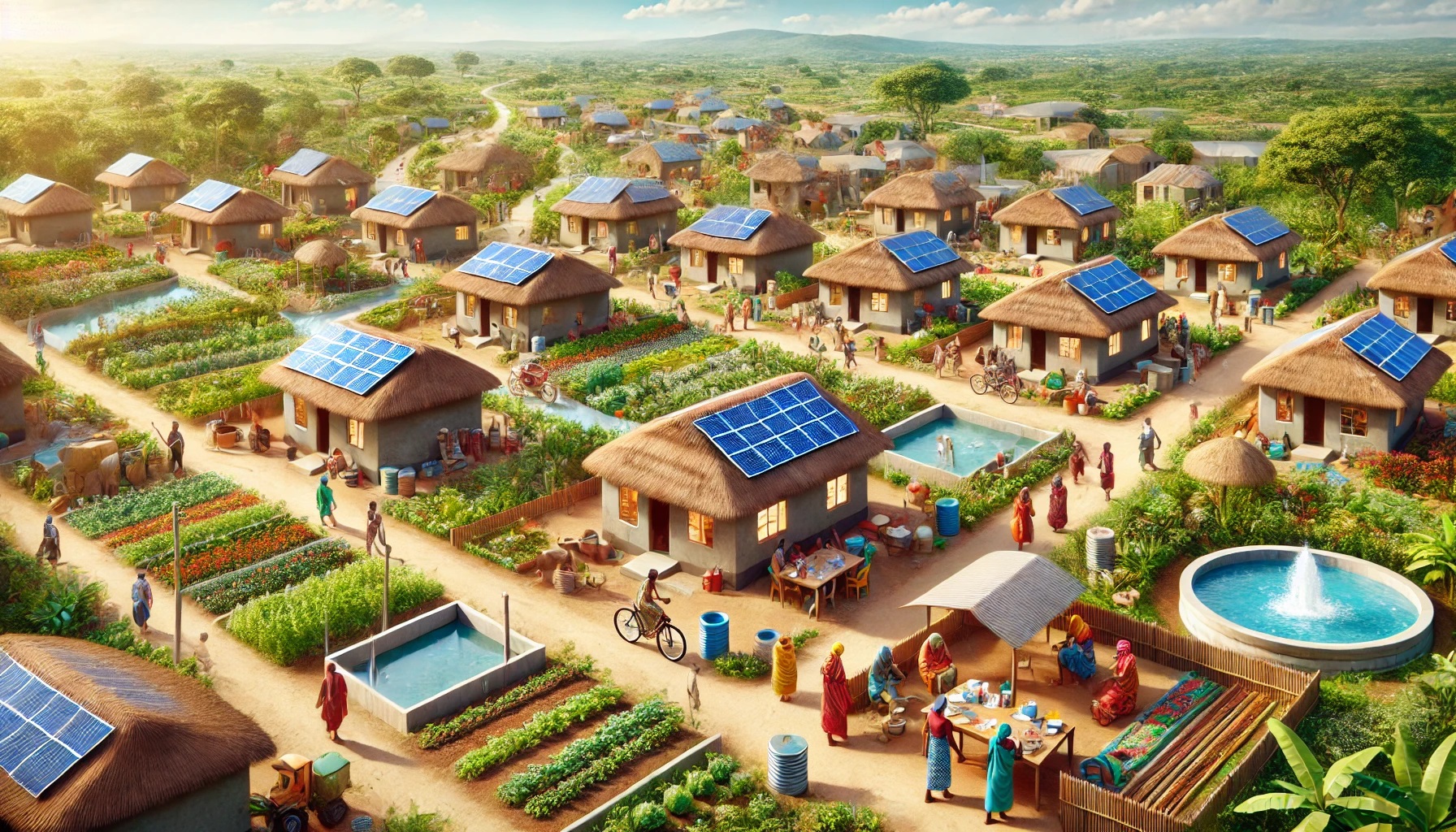
An illustration depicting how housing and settlement activities can help alleviate poverty in rural Africa. It highlights sustainable housing, solar energy, access to education, healthcare, and farming activities, promoting community empowerment and economic growth.
Housing and settlement conditions in rural Africa are often characterized by inadequate infrastructure, limited access to basic services, and poor construction materials. Most rural homes are made from mud, thatch, or wood, which lack durability and insulation. Poor housing contributes to health issues, limits productivity, and perpetuates poverty. However, improving housing and settlement in rural areas can play a significant role in poverty alleviation.
Adequate housing provides a foundation for better health outcomes. Improved homes with proper ventilation, sanitation, and roofing reduce the prevalence of diseases such as respiratory infections and malaria. Healthier families are more productive and spend less on medical expenses, allowing them to invest in education, farming, or small businesses.
Access to essential services in settlements, such as clean water, electricity, and roads, can transform rural economies. Infrastructure development not only enhances the quality of life but also facilitates trade, education, and access to healthcare. Electrification enables productive activities like food preservation and small-scale manufacturing, while better roads connect rural producers to markets, increasing their income potential.
Affordable and durable housing programs, combined with community-driven initiatives, can create jobs in construction and related sectors. Utilizing local materials and skills further stimulates the rural economy.
In conclusion, improving housing and settlement in rural Africa is not merely a matter of infrastructure but a pathway to breaking poverty cycles. By investing in sustainable housing and community development, governments and organizations can foster economic growth, health, and stability, creating a foundation for a prosperous future.
PROJECTS
These initiatives address various housing challenges in Africa, from providing affordable homes and improving living conditions in informal settlements to fostering sustainable development and resilience. By addressing the intersection of housing, health, education, and economic stability, we can help alleviate poverty and improve quality of life across the continent.
Affordable Housing Construction: Build low-cost, durable homes for low-income families, utilizing locally available materials and labor to reduce construction costs and make housing affordable.
Housing Microfinance Programs: Provide micro-loans or credit to low-income individuals to enable them to build, renovate, or improve their homes. This can empower families to create better living conditions over time.
Slum Upgrading and Redevelopment: Implement programs to improve the living conditions of people in informal settlements by upgrading infrastructure, improving sanitation, and providing better housing.
Construction Skills Training: Offer training in construction skills, such as bricklaying, carpentry, and plumbing, to create jobs and empower local communities to build their own homes or participate in housing projects.
Land Tenure and Property Rights Advocacy: Advocate for legal reforms and policies that secure land tenure for informal settlers, enabling them to own or legally lease land and access housing finance.
Sanitation and Clean Water Solutions: Improve housing environments by providing sanitation facilities (toilets, sewage systems) and clean water infrastructure to slums and informal settlements, improving health outcomes.
Sustainable Building Materials: Promote the use of sustainable, eco-friendly building materials (e.g., bamboo, compressed earth blocks, and recycled materials) to reduce environmental impact and make housing more affordable.
Energy-Efficient Housing: Design and construct homes with energy-efficient features such as solar panels, improved insulation, and natural ventilation to reduce utility costs for low-income households.
Emergency Shelter Programs: Provide temporary shelters for people displaced by natural disasters or conflict, ensuring they have a safe place to stay while longer-term solutions are developed.
Affordable Rental Housing Projects: Develop low-cost rental housing options for families who cannot afford to purchase homes, ensuring access to decent housing for more people.
Community-Based Housing Cooperatives: Create housing cooperatives where communities can pool resources to collectively build or purchase homes, reducing costs and fostering shared ownership and management.
Urban and Rural Housing Development Planning: Develop comprehensive housing strategies for urban and rural areas, ensuring that housing development aligns with broader economic and social goals, including access to jobs, education, and healthcare.
Water and Energy Access in Housing Projects: Integrate renewable energy solutions (such as solar power) and access to clean water in new housing developments, improving living standards and reducing dependency on costly energy sources.
Resilient Housing for Climate Adaptation: Build climate-resilient homes designed to withstand extreme weather conditions such as floods, droughts, or storms, especially in areas vulnerable to climate change.
Affordable Home Improvement Programs: Offer grants or small loans for families to improve the condition of their existing homes, including repairing roofs, fixing walls, or upgrading kitchens and bathrooms.
Self-Build Housing Support: Provide support for self-build initiatives, where families receive technical assistance, materials, and financial resources to build or improve their own homes.
Inclusive Housing for Disabled People: Design and construct accessible housing for people with disabilities, incorporating features such as ramps, wider doorways, and specialized toilets to ensure everyone can live comfortably and independently.
Social Housing for Vulnerable Groups: Develop housing projects specifically for vulnerable groups, such as the elderly, orphans, refugees, or people living with HIV/AIDS, ensuring they have access to safe and secure living environments.
Land Use and Urban Planning Education: Educate communities and local governments on the principles of sustainable urban planning, zoning laws, and land use management to prevent overcrowding, poor settlement planning, and unsafe living conditions.
Affordable Home Insurance: Introduce affordable home insurance programs for low-income families to help protect their homes from damage caused by natural disasters or accidents, reducing financial burdens when housing is affected.
POVERTY ALLEVIATION INITIATIVE
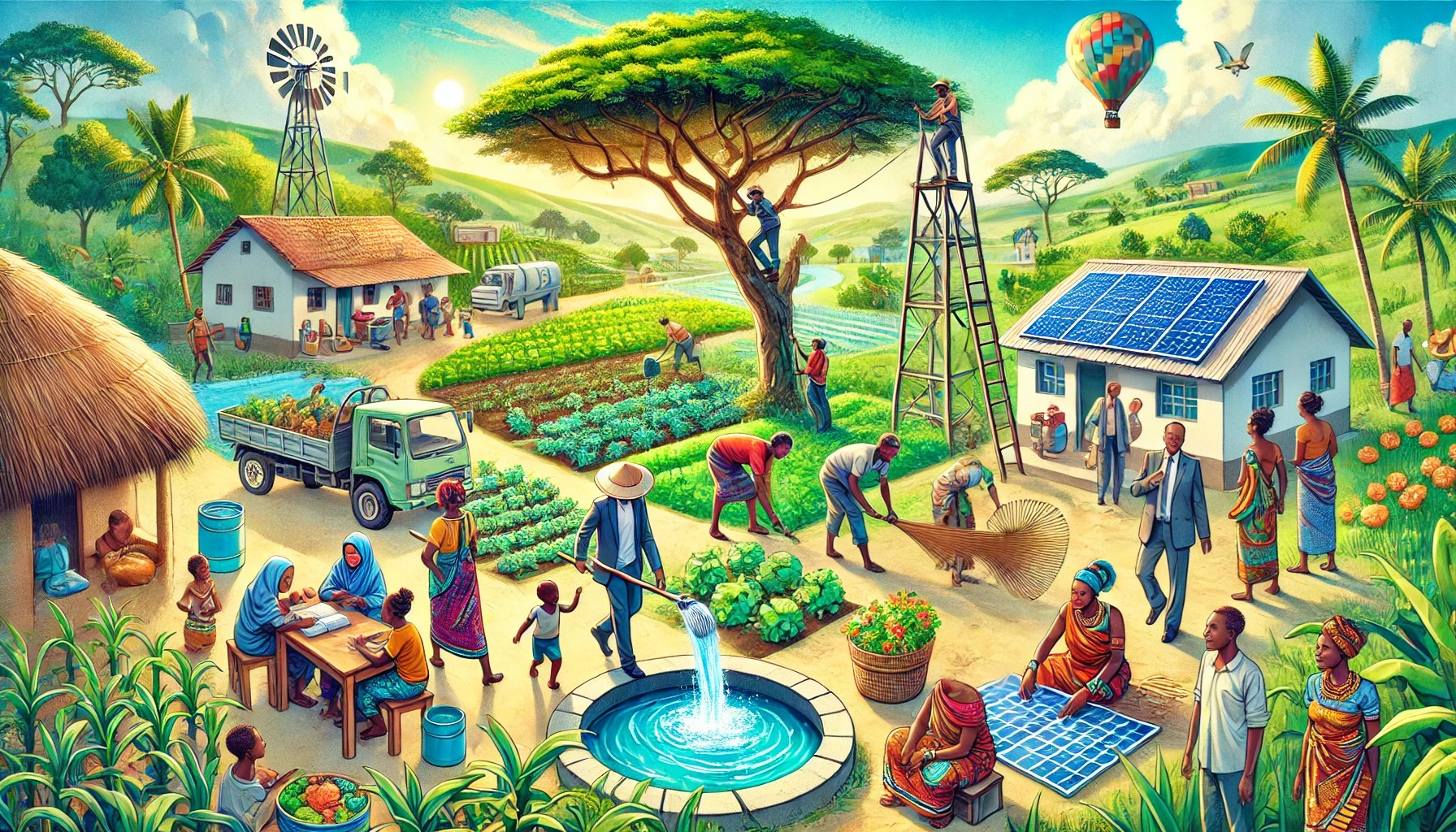
An illustration showcasing various activities that aid in alleviating poverty in rural Africa. It highlights agriculture, education, small businesses, access to clean water, renewable energy, healthcare, and trade—each contributing to community empowerment and development.
Poverty alleviation in Africa is a crucial aspect of fostering sustainable development across the continent. With over 40% of Sub-Saharan Africa’s population living below the poverty line, addressing this challenge requires a multifaceted approach that combines economic, social, and environmental strategies.
One key method of alleviating poverty lies in empowering rural communities through infrastructure development. Building affordable and sustainable housing can provide stability and improve living conditions, while access to clean water and sanitation reduces health risks, enabling communities to thrive. Investments in renewable energy, such as solar power, help bridge the energy gap, fostering small businesses and improving educational outcomes.
Agricultural development also plays a pivotal role in reducing poverty. Enhancing farming techniques, improving access to markets, and offering financial services, such as microloans, empower farmers to increase productivity and income. Diversifying rural economies by promoting small-scale industries and entrepreneurship can further reduce dependency on agriculture and create new job opportunities.
Education is a cornerstone of poverty alleviation. By ensuring equitable access to quality education, particularly for girls and marginalized groups, Africa can nurture a skilled workforce capable of driving economic transformation. Additionally, healthcare investments combat diseases that disproportionately affect impoverished communities, breaking the cycle of poverty.
Finally, robust governance and community involvement are essential. Transparent policies, inclusive decision-making, and support for grassroots initiatives ensure sustainable development tailored to local needs. By combining these efforts, Africa can create pathways to prosperity, uplifting millions from poverty and unlocking its full potential.
PROJECTS
These initiatives can help address the multifaceted nature of poverty by improving access to basic needs such as education, healthcare, clean water, and sustainable livelihoods while empowering individuals and communities to take control of their development. We aim to have a transformative impact by targeting these areas with integrated, community-driven approaches.
- Education Access and Support Programs:
Provide scholarships, school supplies, and educational infrastructure to improve access to education, particularly for girls and marginalized communities, increasing long-term economic opportunities. - Vocational Training and Skills Development:
Offer vocational training programs in skills like carpentry, welding, tailoring, and IT to enhance employability and create income-generating opportunities for youth and adults. - Microfinance and Financial Literacy Programs:
Provide micro-loans and financial literacy training to empower individuals and small businesses, particularly women, to start businesses, manage finances, and escape poverty. - Clean Water and Sanitation Projects:
Develop clean water access points (wells, boreholes) and sanitary infrastructure (toilets, waste management) in rural and underserved communities to reduce waterborne diseases and improve health. - Affordable Housing Projects:
Construct low-cost, safe, and sustainable housing for low-income families, particularly in urban slums and rural areas, ensuring better living conditions and access to services. - Agricultural Support and Food Security Programs:
Provide agricultural training, seeds, tools, and irrigation systems to farmers to increase crop yields, improve food security, and reduce hunger in rural areas. - Renewable Energy Solutions:
Install solar panels, biogas systems, and other renewable energy technologies in communities without electricity, improving living standards and providing clean, sustainable energy. - Healthcare Access Programs:
Build or support healthcare clinics, provide medical supplies, and offer training for local healthcare workers to improve access to basic healthcare services, including maternal and child health. - Community-based Early Childhood Development (ECD):
Support and establish early childhood education centers that focus on holistic development, ensuring that children in impoverished areas have access to early education and support for long-term success. - Youth Empowerment and Leadership Programs:
Create leadership training, mentorship, and entrepreneurship programs for youth, enabling them to gain skills, build confidence, and become agents of change in their communities. - Environmental Conservation Projects:
Promote reforestation, sustainable farming practices, and waste management to protect natural resources, improve ecosystems, and ensure that communities can depend on healthy environments for survival. - Gender Equality and Women’s Empowerment:
Support initiatives that empower women through education, legal rights, entrepreneurship, and access to healthcare, helping them achieve economic independence and improve community well-being. - Community-based Health Insurance:
Create or support affordable health insurance schemes that allow families to access essential healthcare without facing financial hardship, improving health outcomes in underserved communities. - Livelihood Diversification and Entrepreneurship:
Support income-generating projects, such as small businesses, through micro-financing, training, and market access, helping individuals and families increase their income sources and reduce poverty. - Disaster Relief and Emergency Aid:
Provide emergency food, water, medical aid, and shelter to communities affected by natural disasters or conflicts, helping them recover and rebuild their lives. - Child Protection and Social Welfare Services:
Establish child protection systems, such as safe houses and educational programs, to protect vulnerable children from exploitation, abuse, and trafficking, providing them with opportunities for a better future. - Mobile Health Clinics: Implement mobile clinics to reach remote or underserved populations with essential health services, including vaccinations, maternal care, and basic health check-ups.
- Legal Aid and Human Rights Advocacy:
Provide legal support to vulnerable populations, including land rights advocacy, access to justice, and legal representation for marginalized communities, ensuring their rights are protected. - Financial Inclusion Programs:
Facilitate access to banking services, mobile money platforms, and savings programs, especially for unbanked populations, enabling them to save, send remittances, and access credit. - Nutrition and Food Assistance Programs:
Run nutrition education and food assistance programs, particularly for malnourished children and pregnant women, improving health and reducing the cycle of poverty caused by poor nutrition.
